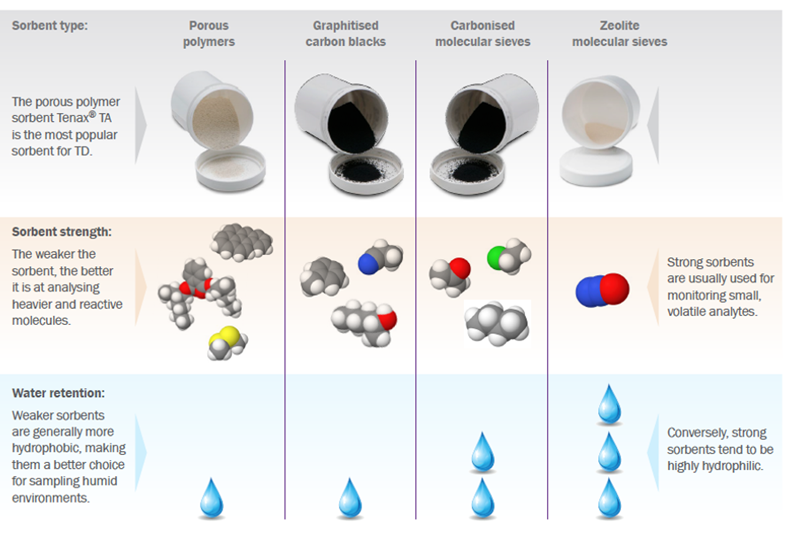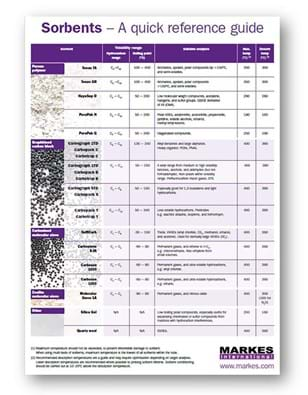
Tenax, Carboxen and other sorbents used for thermal desorption sampling
26 May, 2020
How correct sorbent choice is essential for tube-based TD
Sorbent choice is one of the most critical factors in tube-based thermal desorption. If the sorbent(s) aren’t strong enough to retain the compounds of interest during sampling, no amount of instrument manipulation will allow you to see them in the chromatogram.
Choosing the right sorbent or sorbent combinations can sometimes seem confusing, particularly when analysing unknown samples. People will often start by asking for brand names such as Tenax® or Carboxen. These are sensible choices for many applications – but they aren’t the best choice for everything and there may be more hydrophobic, thermally stable, or cost-effective options available which would make the sampling and analysis easier.
Sorbents selectively trap and retain compounds of interest while excluding the bulk constituents of air such as permanent gases and (ideally) water. Selectivity can also be used to eliminate some interferences and enhance results for low-level compounds. Provided tubes are carefully sealed, the retained compounds can usually be stored safely on the tube for several days or weeks ready for thermal desorption and analysis using heat and a flow of carrier gas.
There are several key considerations when choosing sorbents for TD:
- Strength: A sorbent has to be strong enough to retain target analytes but able to release them efficiently during desorption. As a rough guide:
- Use a weak sorbent, such as Tenax TA, when working with compounds boiling above 100°C.
- Use a medium-strength sorbent, such as a graphitised carbon black, for compounds boiling between 30°C and 100°C.
- Use a strong sorbent, such as a carbon molecular sieve, for compounds boiling in the range –48°C to 30°C.
- Compounds with boiling points below –48°C are typically too volatile for ambient-temperature sorbent sampling.
- Thermal stability of sorbent and compounds of interest: 1.Consider maximum operating temperatures. Some sorbents cannot be heated above certain temperatures without causing irreversible damage, and some compounds of interest can’t be heated above certain temperatures without undergoing some degradation.
- Inertness: Reactive species are more suited to inert sorbents, so try to avoid non-inert sorbents such as graphitised carbon blacks and use an inert tube material, either glass or inert-coated stainless steel.
- Artefact levels: Some sorbents, such as the carbon blacks, exhibit low artefact levels, making them ideal for ultra-trace level analysis. Others can have higher artefact levels causing background noise or potential interferences with certain analytes.
- Hydrophobicity: Needs to be considered to avoid water retention on tubes sampled in a humid environment. Where possible, hydrophilic sorbents, such as carbonised molecular sieves, should be avoided when working in high humidity.

The types of available sorbents are grouped as follows:
- Porous polymers: Most porous polymer sorbents are inert, making them suitable for the analysis of labile and reactive compounds such as terpenes and CS gas.
- Graphitised carbon blacks: These are non-specific carbon sorbents, widely used for trace-level applications due to their minimal artefact levels. Examples are Carbograph, Carbopack and Carbotrap.
- Carbonised molecular sieves: These are the strongest sorbents and are used to trap the most volatile compounds. Examples are SulfiCarb, Carboxen 1000 and Carboxen 1003.
- Zeolite molecular sieves: These are very selective hydrophilic sorbents used for specific applications.
Can I use more than one sorbent in a tube?
Multi-bed tubes, able to screen a wide range of compounds, are growing in popularity, especially for indoor air applications and research. With active (pumped) sampling, a common practice is to combine up to three sorbents, to increase the volatility range that can be collected. In such cases, a good choice for reliably sampling a wide analyte range (about C3 to n-C32) would be three separate beds – a porous polymer, graphitised carbon black and carbonised molecular sieves.
After sampling, the tubes should be desorbed in the TD instrument in the opposite direction to sampling. This sampling/desorption process is then replicated during transfer to the focusing trap, where analytes pass onto the weakest sorbent bed first and are desorbed in the opposite direction (known as backflush operation)–– this is a feature with all Markes systems.
Note that single sorbent tubes are more commonly used for passive (diffusive) sampling. Multi-bed tubes can be used diffusively, but only the first sorbent (nearest the sampling end) plays any part in the passive sampling process.
Can I use sorbents for untargeted analysis?
There are many sorbent combinations that can be used to sample analytes over a wide volatility range. Markes offers a large choice of versatile, general purpose tubes for broad-ranging samples, ideal for research and screening purposes where untargeted analytes may be of interest. Our range of pre-packed sorbent tubes also includes sorbent combinations tailored to the requirements of specific targeted applications and methods.
Pre-packed sorbent tubes are available in the following tube types:
- Stainless steel, inert-coated stainless steel and glass industry-standard 3.5” thermal desorption tubes.
- DAAMS tubes (Depot Area Air Monitoring Systems) used for air sampling in chemical defence and counter-terrorism applications, available in 4.5” and 3.5”. These are packed to ensure optimum recovery of challenging and toxic analytes such as chemical agents.
- Glass TD Mini-tubes for use with Gerstel TD systems, packed with popular sorbents.
Do I need to match the sorbent in my focusing trap to the sorbent in my tubes?
In most cases, a general-purpose trap will be suitable for use with a variety of sorbent tube combinations, enabling flexibility between applications in an analytical sequence. For very specific applications it may require use of a different trap, and matching it to the sorbent tube can be a good place to start. Look out for a future blog on focusing traps and sorbents.
Where can I get more advice?
Markes provides unrivalled expertise in sorbent selection and the broadest range of sorbent packings for sampling known and unknown compounds of interest. Our sorbent tubes and focusing traps have been designed by TD experts and optimised for key applications and methods to simplify system and method set-up. We also provide tubes and traps suited to wide-analyte-range applications for the sampling of unknowns. We can offer advice on which trap is best suited to your sorbent tubes or to your online sampling method. Alternatively, we can custom pack according to your needs. Contact our sales team to discuss your requirements – enquiries@markes.com








